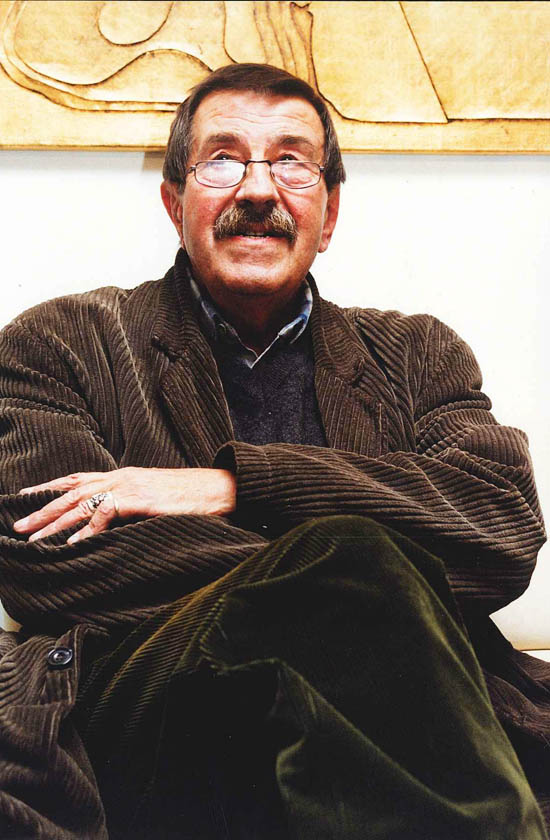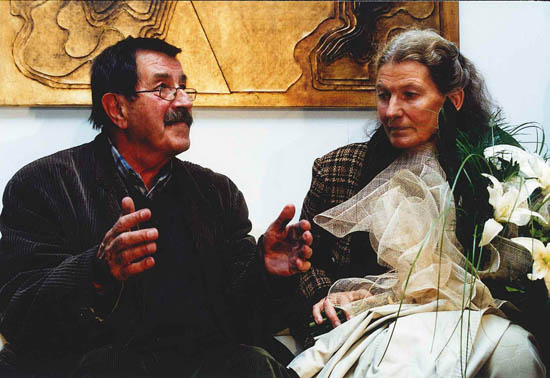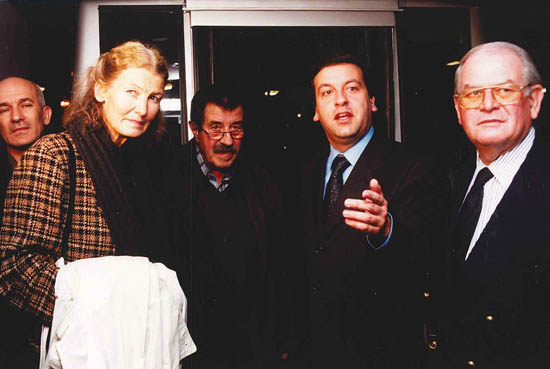
German writer Günter Grass, Nobel Prize for Literature in 1999, died this Monday aged 87, in a clinic in Lübeck, Germany, announced the author's publisher.
The writer, poet, playwright and visual artist, born in Danzig (now Gdansk, Poland) on 18 October 1927, had a long connection to the Algarve, where he owned a house he considered "a retreat".
Günter Grass had had a house between Vale das Eiras and Carriçal, in the parish of Mexilhoeira Grande (Portimão), since the 80s. , among twisted carob and fig trees.
There, surrounded by the silence of nature, interrupted only by the noise of animals, without television, Grass spent long periods, especially in spring and autumn, with his numerous family and friends. There he occupied himself with writing, drawing, reviewing texts.
But the longest and most visible connection between Grass and the Algarve is through the Cultural Center of São Lourenço (CCSL) in Almancil, where he presented books and exhibited several times. "Günter Grass had a debut connection with Volker and Marie Huber, the owners of the Cultural Centre, of whom he was a close friend," he told the Sul Informação designer Cristina Palma, who was responsible for the exhibitions at that important cultural center in the Algarve, which ended in 2012.
Marie Huber: “We've known each other since the early 80s, when Günter came here to São Lourenço with his wife and some of the children. He had a big family and they all spent their holidays in the Algarve».
Marie Huber, for her part, told our newspaper: “we've known each other since the early 80s, when Günter came here to São Lourenço with his wife and some of the children. He had a big family and everyone spent their holidays in the Algarve. Once they came here to the Cultural Centre, my husband and I welcomed them, we sympathized with each other and decided to work together».
The first exhibition was held in 1984, when the artist exhibited at the CCSL sculptures, drawings and engravings relating to the book «Die Blechtrommel» («The Drum»), released in 1956, and presented the film based on his work, by the German director Volker Schlondoff.
Since then, “every two years we always had an exhibition of him”, recalls Marie Volker. “He would launch a book, we would launch the book here and an exhibition with his works that illustrated that book”, he adds. Over the years, and up to 2005, "we must have done a dozen or more Gunter Grass exhibitions" at CCSL, he adds.

The last one, in 2005, featured engravings made by Grass to illustrate a book of short stories by Hans Christian Andersen.
But it was not only at the São Lourenço Cultural Center that the artist exhibited in the Algarve. In 2003, his work was shown at the Museu de Tavira/Palácio da Galeria. Jorge Queiroz, director of the Museum, recalls that the exhibition was called «Günter Grass – 50 years old – plastic work», having been named as «the biggest exhibition ever in the Iberian Peninsula» by Marie Huber, who collaborated in the initiative.
«It was an exhibition that occupied the entire Palace, with watercolor, sculpture, drawing and engraving. Marie Huber and Günter Grass came here before, to talk about the exhibition and get to know the space, and he really liked the Palace», recalls Jorge Queiroz.
From this exhibition, which was the German artist's penultimate in the Algarve region and which attracted «thousands of visitors», a work «offered by Grass» and a catalog signed by him remained in Tavira, in the Museum's collection.
After decades of deep connection to the region, in 2010, when, for health reasons, he no longer came to the Algarve, Günter Grass still accepted to be one of the top sponsors of the 1st (and only) Algarve International Literature Festival, which took place in several Barlavento, in Lagoa, Portimão, Aljezur and Armação de Pêra.
Cristina Palma: Günter Grass was “a man who loved to tell stories. We would sit with him by the fireplace and he would tell stories. It was fascinating».
Marie and her husband Volker Huber, who died in 2004, were Grass's great Algarvian friends. Marie describes the writer as "a very convivial person, who really enjoyed talking, meeting people, welcoming friends."
Grass was particularly fond of Algarve fish and, when he spent long periods in his retreat in Vale das Eiras, he himself went to the squares of Portimão or Lagos to buy fresh fish. His oven-roasted fish in the Algarve was famous among his friends.
Some of his drawings, curiously, were made with ink from the squid, cuttlefish or octopus that he bought in the market to eat. Motifs linked to the Algarve's daily life, in fact, were common in his plastic work, namely the grilled fish, the twisted trunks of the carob trees, the fig trees. And, in his writings, the Algarve was also present, sometimes with small notes from daily life, as in the travel diary «Em Viagem – From One Germany to Another», in which Grass often talks about his cooking with local products.
Cristina Palma, for her part, remembers Gunter Grass as “an extremely calm man, always with a pleasant word, very kind, who loved to tell stories. We would sit with him by the fireplace and he would tell stories. It was fascinating».
Jorge Queiroz, director of the Museum of Tavira, describes Günter Grass as “a man full of humor and very perceptive, because of the observations and comments he made. I remember him saying: “Look at what life is: I, who have a degree in Visual Arts, ended up being a Nobel Prize in Literature”.

In recent years, despite keeping the house in Vale das Eiras, Grass no longer came to the Algarve, as he was banned from traveling for health reasons. The Algarve house, he confessed several times, was his "retreat", "a refuge where he could work calmly", recalls Marie Huber.
Grass, always restless, did not come to the Algarve to rest, far from it: “I don't think he even knew what the word rest was”. During his stay in the region, he dedicated «always a few hours writing so many pages, drawing. He always had a work plan, which he fulfilled», reveals Marie.
Günter Grass won the Nobel Prize for Literature in 1999. In his acceptance speech, used to the controversy caused by his books, Grass said that reactions to his work had shown him that “books can cause offense, trigger fury, even hatred".
His debut book “The Drum” (1956), a mixture of fantasy, family saga and political fable, was attacked by critics, denied the Bremen Literature Prize and even burned in Dusseldorf… -if one bestseller on a world scale, definitively launching the writer, who, curiously, had even graduated in sculpture and graphic design, facets he never abandoned.
But the big controversy came in 2006, when the German writer, at the age of 78, released his autobiography "Peeling the Onion", in which he reveals parts of his life that shocked the world, namely the fact that he was a volunteer at the age of 17 , from the elite troop Waffen-SS during World War II, something that his markedly left-wing position did not allow for
Jorge Queiroz: Günter Grass was «a man full of humor and very perceptive, because of the observations and comments he made».
At the time, Grass was heavily attacked, particularly by means linked to international Judaism, but he was defended by some of his friends, such as the Portuguese Nobel laureate José Saramago. «He was 17 years old. And the rest of life doesn't count? It seems to me a hypocritical reaction, from many people who perhaps do not consult their own conscience. Many people want to find clay in influential personalities,” José Saramago told Spanish daily El País.
Marie Huber, on the other hand, in an interview she gave to Agência Lusa, considered this episode in Grass' life as a «youth daydream, it was already known that he felt a great fascination for uniforms» and classified the controversy as «a fox transformed into an elephant'. Why did he wait for 78 years to make this revelation? “Maybe I hadn't found the right time to do it and I was afraid of letting people down”, said Marie, for whom “it is for these revelations that biographies are used”.
Controversial to the end, a great friend of the Algarve, Günter Grass died today in the city of Lübeck, where he lived.


















Comments